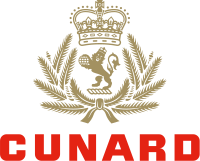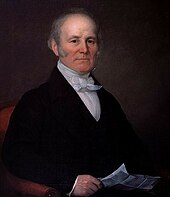 | |
| Company type | Subsidiary |
|---|---|
| Industry | Shipping, transportation |
| Founded | 1840 (as the British and North American Royal Mail Steam Packet Company) |
| Headquarters | Carnival House, Southampton, United Kingdom |
Area served | Transatlantic, Mediterranean, Northern Europe, Caribbean and World Cruises. |
Key people |
|
| Products | Transatlantic crossings, world voyages, leisure cruises |
| Parent | Carnival Corporation & plc |
| Website | www |
Footnotes / references House Flag | |

The Cunard Line (/ˈkjuːnɑːrd/) is a British shipping and cruise line based at Carnival House at Southampton, England, operated by Carnival UK and owned by Carnival Corporation & plc.[1] Since 2011, Cunard and its four ships have been registered in Hamilton, Bermuda.[2][3]
In 1839, Samuel Cunard was awarded the first British transatlantic steamship mail contract, and the next year[4] formed the British and North American Royal Mail Steam-Packet Company in Glasgow with shipowner Sir George Burns together with Robert Napier, the famous Scottish steamship engine designer and builder, to operate the line's four pioneer paddle steamers on the Liverpool–Halifax–Boston route. For most of the next 30 years, Cunard held the Blue Riband for the fastest Atlantic voyage. However, in the 1870s Cunard fell behind its rivals, the White Star Line and the Inman Line. To meet this competition, in 1879 the firm was reorganised as the Cunard Steamship Company Ltd, to raise capital.[5]
In 1902, White Star joined the American-owned International Mercantile Marine Co. In response, the British Government provided Cunard with substantial loans and a subsidy to build two superliners needed to retain Britain's competitive position. Mauretania held the Blue Riband from 1909 to 1929. Her sister ship, Lusitania, was torpedoed in 1915 during the First World War.
In 1919, Cunard relocated its British homeport from Liverpool to Southampton,[6] better to cater for travellers from London.[6] In the late 1920s, Cunard faced new competition when the Germans, Italians and French built large prestige liners. Cunard was forced to suspend construction on its own new superliner because of the Great Depression. In 1934, the British Government offered Cunard loans to finish Queen Mary and to build a second ship, Queen Elizabeth, on the condition that Cunard merged with the then-ailing White Star Line to form Cunard-White Star Line. Cunard owned two-thirds of the new company. Cunard purchased White Star's share in 1947; the name reverted to the Cunard Line in 1950.[5]
Upon the end of the Second World War, Cunard regained its position as the largest Atlantic passenger line. By the mid-1950s, it operated 12 ships to the United States and Canada. After 1958, transatlantic passenger ships became increasingly unprofitable because of the introduction of jet airliners. Cunard undertook a brief foray into air travel via the "Cunard Eagle" and "BOAC Cunard" airlines, but withdrew from the airline market in 1966. Cunard withdrew from its year-round service in 1968 to concentrate on cruising and summer transatlantic voyages for holiday makers. The Queens were replaced by Queen Elizabeth 2 (QE2), which was designed for the dual role.[7]
In 1998, Cunard was acquired by the Carnival Corporation, and accounted for 8.7% of that company's revenue in 2012.[8] In 2004, QE2 was replaced on the transatlantic runs by Queen Mary 2 (QM2). The line also operates Queen Victoria (QV) and Queen Elizabeth (QE). As of 2022, Cunard is the only shipping company to still operate a scheduled passenger service between Europe and North America.
In 2017, Cunard announced a fourth ship would join its fleet.[9] This was initially scheduled for 2022 but delayed until 2024 due to the COVID-19 pandemic. The ship has since been named Queen Anne.[10]
- ^ "Company news; Carnival to buy remaining stake in Cunard Line". The New York Times. 20 October 1999.
- ^ "Cruise Line 'Awaiting Further Updates' On Law". 13 December 2017. Archived from the original on 22 January 2018. Retrieved 22 January 2018.
- ^ Jonathan Bell (21 October 2011). "Luxury cruise ship line Cunard switches to Bermuda registry | Bermuda News". Royalgazette.com. Archived from the original on 9 May 2012. Retrieved 7 November 2012.
- ^ "Cunard". Atlantis Travel. Retrieved 24 May 2023.
- ^ a b Gibbs, Charles Robert Vernon (1957). Passenger Liners of the Western Ocean: A Record of Atlantic Steam and Motor Passenger Vessels from 1838 to the Present Day. John De Graff. pp. 52–92.
- ^ a b The Nautical Gazette. 1919. p. 210.
- ^ Maxtone-Graham, John (1972). The Only Way To Cross. Collier.
- ^ "2012 World Wide Market Share". Cruise Market Watch. 20 November 2011.
- ^ "Carnival Corporation to Build New Cruise Ship for Iconic Cunard Brand | Carnival Corporation & plc". www.carnivalcorp.com. Archived from the original on 23 August 2022. Retrieved 29 July 2022.
- ^ "Cunard Reveals Name of New Ship, Queen Anne". www.travelmarketreport.com. Retrieved 29 July 2022.